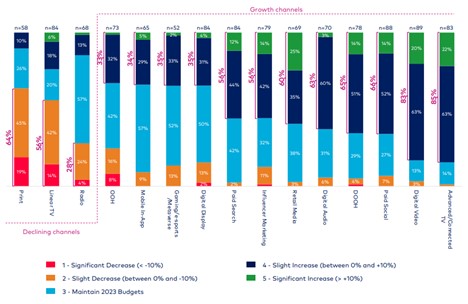Advertising budgets allocated for Connected TV (CTV) are on the rise, while those for traditional linear TV are on the decline.
In fact, 2024 is expected to see an increase of 85% in advertising for connected TV. This is according to a Media Budgets 2024 survey by the World Federation of Advertisers (WFA) and Ebiquity. Linear TV is expected to decrease by 56%.

Where is CTV Advertising Budget Coming from in 2024?
In 2021’s study, linear TV was the primary source of CTV funding for 58% of respondents. However, for this most recent study, linear TV was cited by just 21% of respondents, putting it 6th on the list. Budget is most likely to be shifted in 2024 from social media budgets, according to 66% of respondents, followed by email marketing (43%).
Branding, Ad Relevance, and Audience Targeting are Top 2024 CTV Goals
In a survey by Digiday and MNTN, the primary goals of CTV advertising for 55% of respondents was increased brand awareness. This is similar to linear TV as a channel for driving brand awareness.
Rounding out the top three responses are improved ad relevance for 40% of respondents and precise audience targeting for 39% of respondents.

(Image Source: Marketing Charts)
Measuring Brand Lift
Measuring brand lift from a Connected TV campaign is top of mind for brands in 2024. Conducting surveys before and after your CTV campaign is one of the most direct and effective methods to measure brand lift.
In the pre-campaign survey, gather baseline data on key brand metrics such as brand awareness, consideration, favorability, and purchase intent. After the campaign, conduct a post-campaign survey with the same questions to assess changes in these brand metrics among the exposed audience.
The difference between the pre-campaign and post-campaign survey results indicates the brand lift generated by the CTV campaign.
Additionally, a control vs. exposed group comparison study can be implemented. With this method, two groups are created – one exposed to the CTV campaign and another, the control group, not exposed to the campaign. Measure key brand metrics within both groups, ideally using surveys or other data sources, before and after the campaign.
By comparing the changes in brand metrics between the exposed and control groups, you can directly attribute the lift to the CTV campaign. Be sure that the groups are similar in terms of demographics and other relevant factors to make the comparison valid.
Improved Ad Relevancy Through Precision Audiences
Connected TV improves ad relevancy, specifically compared to traditional television advertising by offering advanced targeting and personalization capabilities.
Audience Targeting
CTV platforms allow advertisers to target specific audience segments based on demographics, interests, behaviors, and other criteria. This precision targeting ensures that ads are shown to viewers who are more likely to be interested in the product or service being promoted.
Advertisers can leverage first-party and third-party data to create detailed audience profiles, enabling them to reach their ideal customers effectively.
Contextual Relevance
CTV is a great channel for contextual targeting, which allows advertisers to place ads within relevant content categories or alongside specific programs and genres. For example, an outdoor gear brand can target its ads to appear during nature and adventure documentaries.
Dynamic Ad Insertion
CTV enables dynamic ad insertion, where ads are inserted into the content stream in real time based on viewer characteristics and behavior. Advertisers can serve different ads to different viewers watching the same program, tailoring the message to each viewer’s preferences and interests.
Data-Driven Insights
CTV platforms provide valuable data and analytics on viewer behavior. Advertisers can access insights such as ad completion rates, click-through rates, and viewability metrics. These insights help advertisers refine their ad creative and targeting strategies, ensuring that future campaigns are even more relevant to their audience.
Top Ranking CTV Ad Formats for 2024
Additional insights from the study focused on top ad formats that brands are using (respondents chose all that apply):
- 15-and/or 30-second TV spots (49%)
- Ad creatives that allow viewer interaction (42%)
- Ads with shoppable QR codes (34%)
- Ad selectors that allow viewer choice (27%)
- Ads with mobile integrations (20%)
- Carousels featuring product/image/video galleries (20%)
CTV advertising in 2024 is clearly poised to continue its rapid growth as it becomes an integral part of the advertising landscape. As technology continues to advance, we can expect to see even more innovations in CTV advertising, including improved measurement and analytics, enhanced targeting capabilities, and greater integration with other digital marketing channels. Advertisers will need to stay agile and adapt to these changes in order to stay competitive in the CTV space.
Additionally, as consumers continue to shift their viewing habits towards streaming services, CTV advertising will become increasingly important for brands looking to connect with their audiences. Advertisers must invest in creative and engaging content that resonates with viewers and aligns with the unique attributes of connected TV.





